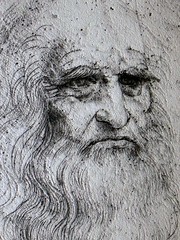This school year is my third working with
Lego NXT Mindstorms robotics kits as a platform for teaching STEM (for those of you not in the know, it's an acronym for Science, Technology, Research & Mathematics). I use these kits with my 8th graders, and together we have learned quite a bit with them.
I recently re-discovered the drawings of Leonardo Da Vinci - and took note of how many of the inventions, contraptions, and military devices he imagined and envisioned resembled the devices and inventions I encourage my own students to invent and create. So I am taking a moment to consider takin' it back, way back, and incorporating some of Leonardo's scientific curiosity into my humble robotics class by way of infusing engineering with an engaging true history.
I'm sure there are many possible approaches to doing this, but the one that strikes me is through an examination of simple machines. To my memory, there are six devices that are included in the classic set of simple machines:
1. Lever
2. Wheel & Axle
3. Incline Plane
4. Screw
5. Wedge
6. Pulley
We have used most of these simple machines, both alone and in combination, in constructions we have already built, but I haven't called attention to them as such.
What might I want my students to know and be able to do at the end of this enterprise?
- Identify simple machines at work in the designed objects of their everyday lives.
- Build a basic working model of each simple machine using our existing Lego Mindstorms kits.
- Effectively choose a appropriate simple machine or combination of simple machines to complete a given task (e.g. move an object).
- Modify the construction of a given simple machine to affect it's efficiency & improve it's strength and quality.
Some of the things I feel I need to learn before I am ready to really roll this out include knowing:
- The terminology to express the various forces at work in the operation of a given simple machine.
- How to adjust the parameters of a given simple machine to adjust the quality of it's output.
While ambitious (at least for someone who naturally tends toward the humanities more than the sciences), I think this is exciting and fruitful interdisciplinary work that the kids may really dig, too.
Anyone out there with a head for mechanical engineering who might want to weigh in?
----------
References & Photo Credits:



